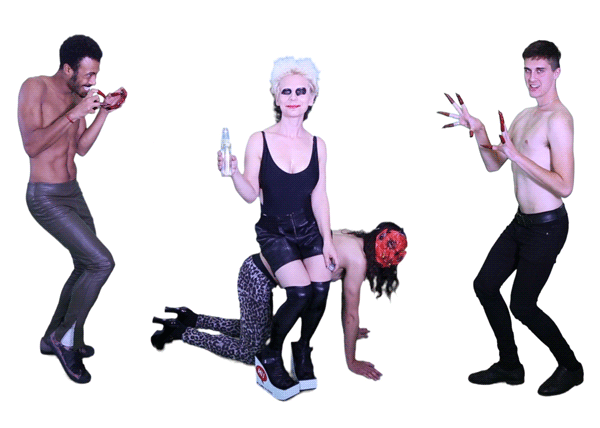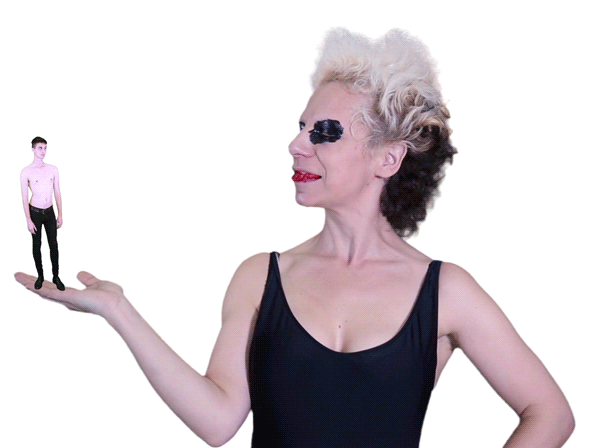Photos: Olimpia Dior
GIFs: Claire Christerson
Text and Interview: Monica Uszerowicz
There are two classes of voyeuristic photography: the kind that render the subject exposed, vulnerable, and almost unaware, and then the sort that do the same to the photographer, for whom documentation is so seemingly natural that even the most banal or intimate moments are worthy of permanent capture. It’s nothing new, this kind of work; in fact it’s de rigeur, but that doesn’t make it any less remarkable when it’s done right.
Filmmaker and photographer Olimpia Dior is this kind of artist, and maybe even better, because the strange liminal space in which her subjects exist—a little raw, a little posed, sometimes ribald and always warm—betrays its time: there’s a classicism to their portrayal, something that recalls earlier decades (despite the frequent appearance of recognizable characters, like India Menuez). We asked her about her craft and the ways in which it seems supplementary to a big, bold movement through the rest of her life.

Where are you from? Where are you now?
I come from Eastern Europe. Now I am in Harlem, in Sugar Hill.
I ask everyone who makes any sort of work at all when they began creating, even if it was during childhood. Tell me about your earliest memories of being able to feel creative.
Since I understood I want to live life my way, I have performed creative life. No need to make any specific artwork—I’d rather focus on performing everyday life and activity with awareness and intention, constantly revisiting every concept I want to answer with my art: how to live, spend time, look at the world, where to focus attention. I continue outside any tradition, with no guru, not following anybody, not imitating anyone, but only finding my own answers how to…everything. I’m finding myself in the most unusual surprising or challenging situation taking photos; Gonzo journalism with only a small dose of hallucination.
When did you pick up a camera, and how?
There were not many people in my childhood who took photographs. Photography seemed something practical, a way to document family or school events. One day I saw an issue of the German magazine, Stern, with a Helmut Newton photograph of a naked woman leaning against a fridge in a kitchen, looking very powerful. I put this photo on the wall and looked at it for a long time, trying to understand what is so appealing to me. Some time later I watched the film Kids and found out about Larry Clark’s photographs. I pretty much lived with Helmut and Larry constantly in my head, thinking: how come they get to witness and photograph all kinds of people in extreme situations? They mainly made me realize I should try photography.




What’s your relationship to your camera like? There is always that moment when you click the shutter that makes you feel a little separate from the moment but then again, it also brings you into the moment in a very present way. I’m wondering how the camera moves with you through your life.
Making visual choices and decisions make me feel high and powerful. For a long time, I believed in a rule of carrying my camera around with me all the time. Now I prefer to plan an encounter with someone who fascinates me and perform a photo shoot—a celebration of time spent with someone who gives me a strong reaction: create a situation, create a room, and recognize the relationship between interior, light, and people in it. I prefer to photograph in daytime—I have a strong passion for daylight. Sunlight is my master. Have to admit the love for high contrast.
What other sorts of work do you do and what is your practice like?
I let myself do whatever I want and believe I could do almost everything. Don’t roll the dice or ask I Ching, but just stay in the moment and try to recognize a photo opportunity. Ideally, I find myself on a film set, participating in a performance or theatre piece while photographing everyone else—engaged from the inside. I develop a relationship with the photographed people. Right now, there are things on my mind like photographing menswear and dancers, making fashion videos and films, shooting rap videos.
Making visual choices and decisions make me feel high and powerful. For a long time, I believed in a rule of carrying my camera around with me all the time. Now I prefer to plan an encounter with someone who fascinates me and perform a photo shoot—a celebration of time spent with someone who gives me a strong reaction: create a situation, create a room, and recognize the relationship between interior, light, and people in it. I prefer to photograph in daytime—I have a strong passion for daylight. Sunlight is my master. Have to admit the love for high contrast.






Do the other facets of your work or practice intersect with your photography in any way?
I don’t take one photo, but a sequence of images existing together, like a fragment of a film, describing action, or transformation. One single image no longer works. I don’t want to just introduce someone—I want to see this person in motion or changing situation. This is definitely inspired by the fact that my primary profession is a filmmaker. I love fashion graffiti and cinema.
When you see a friend in front of a particular background or a movement that catches your attention, what drives you to document it?
Strong, beautiful, one-of-a-kind and very hardcore people inspire me. There is almost always someone in my life who could be called a Muse, someone who makes me feel aesthetically high, the kind of person who creates a paradise for me every time I take a photo of her or him. I see beauty in every photo I took of this person. My most inspiring friends I photograph, like India Menuez, Claire Christerson, Artist 666, Heather Boo, Cinik, Christopher Willauer, Stephen Franco—every photo I take of them is interesting. They have such a big awareness and acceptance of their bodies and beauty, personalities. They effortlessly give a lot to the camera.
Why do you shoot?
I am fascinated by the world and by people. I have been staring at everyone passing me by. Even if you stare for a long time at everyone, something is always fleeting. Nothing and nobody stays the same for longer than a second, a blink of an eye. Things constantly change. Taking photographs let us look at someone and analyze who they were at the moment of capture. Photography helps us understand other people and ourselves. Being a photographer lets you stare as much as you wish without any suspicion. A photographer is entitled by society to stare and analyze, to spend life thinking about light and constantly solving the riddle about how to photograph someone in the best possible way, in the context of interior and light. Daylight is my favorite, as well as very harsh flash.



